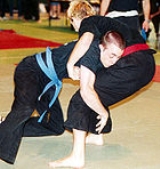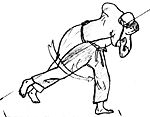
Naban
Encyclopedia

Naban is a style of wrestling from Myanmar
Myanmar
Burma , officially the Republic of the Union of Myanmar , is a country in Southeast Asia. Burma is bordered by China on the northeast, Laos on the east, Thailand on the southeast, Bangladesh on the west, India on the northwest, the Bay of Bengal to the southwest, and the Andaman Sea on the south....
. Related to Tibet
Tibet
Tibet is a plateau region in Asia, north-east of the Himalayas. It is the traditional homeland of the Tibetan people as well as some other ethnic groups such as Monpas, Qiang, and Lhobas, and is now also inhabited by considerable numbers of Han and Hui people...
an and Cambodia
Cambodia
Cambodia , officially known as the Kingdom of Cambodia, is a country located in the southern portion of the Indochina Peninsula in Southeast Asia...
n grappling arts, naban was originally based on Indian wrestling
Malla-yuddha
' is the traditional South Asian form of combat-wrestling created in what is now India, Pakistan, Bangladesh and Sri Lanka...
. It became popular in rural areas where it was often performed at festivals alongside lethwei
Lethwei
Lethwei is an unarmed Burmese martial art. It is similar to related styles of Indochinese kickboxing, namely Muay Thai from Thailand, pradal serey from Cambodia, Muay Lao from Laos and tomoi from Malaysia.- History :...
matches. Naban is most commonly practiced by the tribal peoples of Myanmar. The Chin
Chin people
The Chin , known as the Kuki in Assam, are one of the ethnic groups in Burma. The Chins are found mainly in western part of Burma and numbered circa 1.5 million. They also live in nearby Indian states of Nagaland, Mizoram and Manipur and Assam. Owing to Mizo influence and Baptist missionaries'...
, Kachin
Kachin people
The Kachin people are a group of ethnic groups who largely inhabit the Kachin Hills in northern Burma's Kachin State and neighbouring areas of China and India. More than half of the Kachin people identify themselves as Christians - while a significant minority follow Buddhism and some also adhere...
and Karen
Karen people
The Karen or Kayin people , are a Sino-Tibetan language speaking ethnic group which resides primarily in southern and southeastern Burma . The Karen make up approximately 7 percent of the total Burmese population of approximately 50 million people...
have a reputation for their skilled wrestlers.

Joint lock
A Joint lock is a grappling technique involving manipulation of an opponent's joints in such a way that the joints reach their maximal degree of motion....
s, strikes to pressure point
Pressure point
A pressure point in the field of martial arts refers to an area on the human body that may produce significant pain or other effects when manipulated in a specific manner...
s, and chokehold
Chokehold
A chokehold or choke is a general term for grappling hold that critically reduces or prevents either air or blood from passing through the neck of an opponent. The restriction may be of one or both and depends on the hold used and the reaction of the victim...
s. Any part of the opponent's body is a legal target.
Internal links
- Burmese martial arts or Thaing (burmese)
- BandoBandoBando is a defensive style of thaing focusing on animal-based techniques. The earliest meanings of the word were self-discipline, self-development and self-improvement. Later, it came to mean self-protection or self-defense...
- BanshayBanshayBanshay is a weapon-based Burmese martial art focusing primarily on the sword, staff and spear. Influenced by both Chinese and Indian sources, it is also closely related to krabi krabong and thang-ta....
- LethweiLethweiLethwei is an unarmed Burmese martial art. It is similar to related styles of Indochinese kickboxing, namely Muay Thai from Thailand, pradal serey from Cambodia, Muay Lao from Laos and tomoi from Malaysia.- History :...
- Pongyi thaingPongyi thaingPongyi thaing is a Burmese martial art created by the monk Oopali in the 9th century. Based on the Hindu-Buddhist principle of non-violence and non-aggression, its objective is not to cause maximum harm but simply to defend oneself...
- KarateKarateis a martial art developed in the Ryukyu Islands in what is now Okinawa, Japan. It was developed from indigenous fighting methods called and Chinese kenpō. Karate is a striking art using punching, kicking, knee and elbow strikes, and open-handed techniques such as knife-hands. Grappling, locks,...
See also
- Khmer traditional wrestlingKhmer Traditional WrestlingKhmer traditional wrestling is a folk wrestling style from Cambodia. It has been practiced as far back as the Angkor period and is depicted on the bas-reliefs of certain temples. Although predominantly a male sport today, Khmer wrestling was once practiced by both sexes as female wrestlers are...
- MalakhraMalakhraMalakhra is the South Asian form of sport wrestling, as opposed to malla-yuddha or combat-wrestling. It is mostly played in Pakistan and parts of India. The match begins with both wrestlers tying a twisted cloth around the opponent's waist. Each one then holds onto the opponent's waistcloth and...
- Malla-yuddhaMalla-yuddha' is the traditional South Asian form of combat-wrestling created in what is now India, Pakistan, Bangladesh and Sri Lanka...
- Mongolian wrestlingMongolian wrestlingMongolian wrestling, known as Bökh , is the folk wrestling style of Mongols in Mongolia, Inner Mongolia and other regions...
- Shuai jiaoShuai jiaoShuai jiao is the general Mandarin Chinese term for wrestling. As a generic name, it may be used to cover various styles of wrestling practised in China in the form of a martial arts system or a sport. The narrower term pertains to wrestling styles of the North China Plain...

